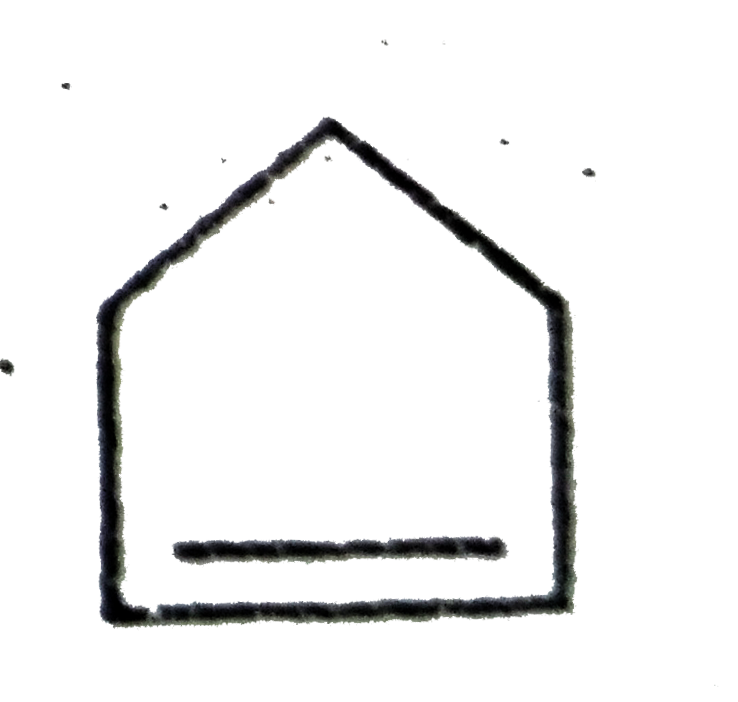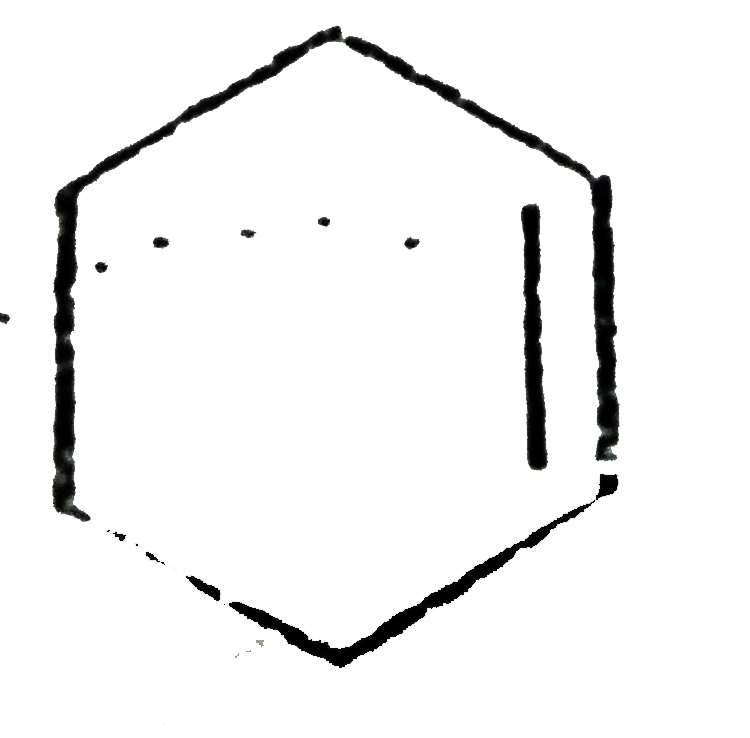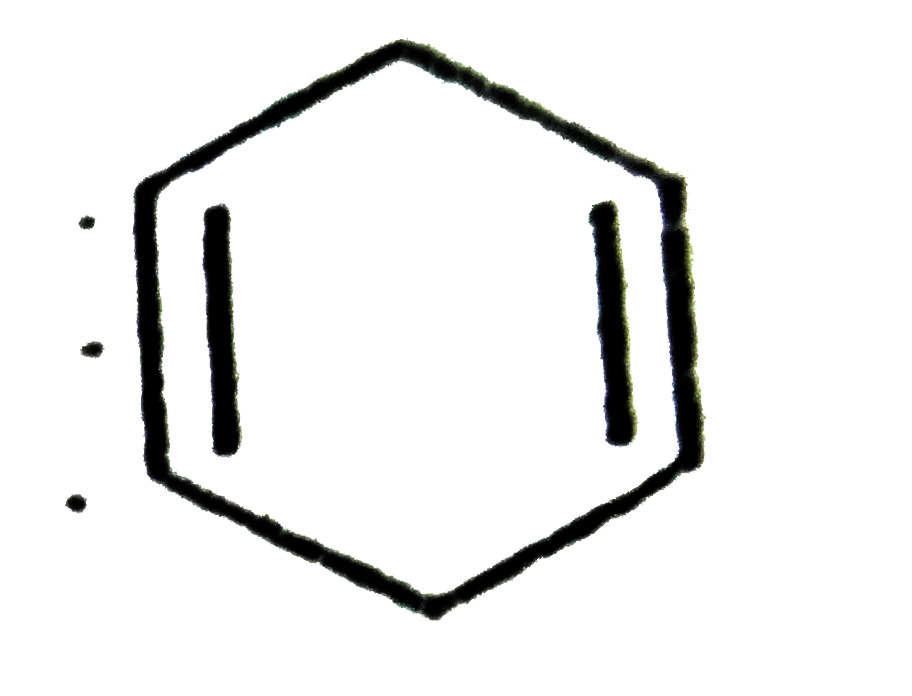Point out A in the given reaction sequence




The correct Answer is:C
To determine the compound A in the given reaction sequence, we need to analyze the entire reaction process step by step.
Step 1: Understanding the Reaction Sequence
The reaction sequence is given as:
AO3/H2O2−−−−−→BΔ−→2CH3COOH+CO2
Here, A is a reactant that undergoes ozonolysis followed by a heating step that produces acetic acid (CH₃COOH) and carbon dioxide (CO₂).
Step 2: Identifying the Type of Reaction
The first part of the reaction involves ozonolysis, which is a reaction of alkenes with ozone (O₃) followed by a reductive workup (in this case, hydrogen peroxide, H₂O₂). Ozonolysis typically cleaves carbon-carbon double bonds (C=C) to form carbonyl compounds.
Step 3: Analyzing the Product B
The product B must be a compound that, upon heating, can decarboxylate to yield two moles of acetic acid (CH₃COOH) and one molecule of carbon dioxide (CO₂). This indicates that B must contain two carboxylic acid groups that can lose CO₂ upon heating.
Step 4: Considering Possible Structures for A
Since we are looking for a compound A that can yield the products mentioned, we need to consider alkenes that, when ozonolyzed, can produce a compound with two carboxylic acid groups.
1. Cyclopentene: Ozonolysis would yield butanoic acid, which does not match our product.
2. Cyclohexene: This could yield a structure that might not lead to the required products.
3. Cyclohexa-1,4-diene: This compound has two double bonds and can produce two moles of acetic acid upon ozonolysis and subsequent heating.
4. Cyclobuta-1,3-diene: This would yield oxalic acid, which does not match our product requirement.
Step 5: Confirming the Correct Option
After analyzing the options:
- Cyclohexa-1,4-diene is the only compound that, upon ozonolysis, can yield a structure that can decarboxylate to form two moles of acetic acid and one molecule of carbon dioxide.
Conclusion
Thus, the compound A is Cyclohexa-1,4-diene.
The reaction sequence is given as:
AO3/H2O2−−−−−→BΔ−→2CH3COOH+CO2
The first part of the reaction involves ozonolysis, which is a reaction of alkenes with ozone (O₃) followed by a reductive workup (in this case, hydrogen peroxide, H₂O₂). Ozonolysis typically cleaves carbon-carbon double bonds (C=C) to form carbonyl compounds.
The product B must be a compound that, upon heating, can decarboxylate to yield two moles of acetic acid (CH₃COOH) and one molecule of carbon dioxide (CO₂). This indicates that B must contain two carboxylic acid groups that can lose CO₂ upon heating.
Since we are looking for a compound A that can yield the products mentioned, we need to consider alkenes that, when ozonolyzed, can produce a compound with two carboxylic acid groups.
2. Cyclohexene: This could yield a structure that might not lead to the required products.
3. Cyclohexa-1,4-diene: This compound has two double bonds and can produce two moles of acetic acid upon ozonolysis and subsequent heating.
4. Cyclobuta-1,3-diene: This would yield oxalic acid, which does not match our product requirement.
After analyzing the options:
- Cyclohexa-1,4-diene is the only compound that, upon ozonolysis, can yield a structure that can decarboxylate to form two moles of acetic acid and one molecule of carbon dioxide.
Thus, the compound A is Cyclohexa-1,4-diene.
Topper's Solved these Questions
- BOOK - AAKASH INSTITUTECHAPTER - HYDROCARBONSEXERCISE - SECTION-C OBJECTIVE TYPE QUESTIONS (MORE THAN ONE OPTIONS ARE CORRECT)12videos
HYDROCARBONS
- BOOK - AAKASH INSTITUTECHAPTER - HYDROCARBONSEXERCISE - SECTION-D LINKED COMPREHENSION TYPE QUESTIONS6videos
HYDROCARBONS
- BOOK - AAKASH INSTITUTECHAPTER - HYDROCARBONSEXERCISE - ASSIGNMENT SECTION-A COMPETITION LEVEL DIFFER BY50videos
HYDROCARBONS
- BOOK - AAKASH INSTITUTECHAPTER - HALOALKANES AND HALOARENES EXERCISE - ASSIGNMENT SECTION -D15videos
HALOALKANES AND HALOARENES
- BOOK - AAKASH INSTITUTECHAPTER - HYDROGENEXERCISE - ASSIGNMENT (SECTION - D) (Assertion-Reason Type question)15videos
HYDROGEN
Similar Questions
Knowledge Check
- Question 1 - Select One
Find out (A) in the given reaction sequence:
(A)O3/H2O−−−−→(B)Δ−−→2CH3COOH+CO2A B
B C
C D
D
- Question 2 - Select One
In the reaction sequence CH3−CH2−COOHH2O2−−→[X]Δ−−→[Y] [Y] will be
ACH3−OH∣CH−COOHBCH2=CH−COOHCOH ∣ CH2−CH2−COOHDLactide - Question 3 - Select One
In the given reaction X is
CH3CHO+CH2(COOH)2Pyridine/Δ−−−−−−−→XACH3COOHBC2H5COOHCCH3CH=CH−COOHD(COOH)CH=CH−(COOH)
In the reaction sequence CH3CHONH2OH/⊕H−−−−−−−→(A)P2O5/Δ−−−−−→(B), B will be
View SolutionThe end product in the reaction is:
CH3CONH2P2O5−−→BH2,Ni−−−→CHNO2−−−→DCu−−→300∘EView SolutionThe major product (Y)in the following reaction sequency is :
CH3−CH3∣CH−CH=CH2Br2/H2O−−−−−→Xconc.H2SO4/Δ−−−−−−−−−→YView SolutionIn the following sequence of reaction, the end product is :
HC≡CHHg2+/H2SO4−−−−−−−−→(A)CH3MgX−−−−−→[H2O](B)[O]−−→(C)View SolutionWhat are A––,B––,C–– in the following reactions ?
(I) (CH3CO)2CaΔA––
II.CH3CO2HHI−−→RedPb–
(III) 2CH3CO2HP4O10−−−→C––View Solution

